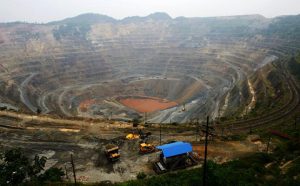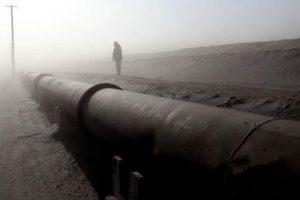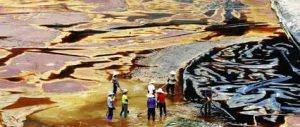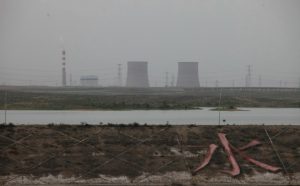China’s steel industry has been in trouble since 2011, with numerous bankruptcies nationwide. The city of Tangshan in Hebei province has been no exception. Though the city is Hebei’s biggest steel maker, with its 70 million tonnes of annual production accounting for almost half of the provincial total and 10% of national output, it too has seen many of its smaller or medium-sized steel firms close or teeter on the edge of bankruptcy. Though this has obvious economic and social consequences, the most enduring cost may be environmental.
Experts say polluted sites left behind by steel firms are a huge problem, and the matter is not being taken seriously enough. The ore dressing, raw material storage, sintering, coking, smelting, casting and rolling processes involved in steel-making all leave the soil and groundwater badly polluted.
Research has shown that while air pollution reduces after a steel mill closes, soil and groundwater pollution persists, and health risks to locals continue to increase. There is currently no nationwide list of such sites, much less any restoration. But the problem exists in the steel-producing regions of Beijing, Hebei, Liaoning, Hubei, Zhejiang and Chongqing.
Zhang Jianhong, an engineer at Shougang Steel’s Research Institute of Technology, took samples from sites the company used to operate at. In 2011 he published research describing the make-up of pollution in different parts of the facility: raw material storage sites suffered moderate heavy metal pollution; sintering sites suffered moderate alkaline metal and dioxin pollution; coking sites were heavily polluted with polycyclic aromatic hydrocarbons (PAHs) and dioxin; while the iron and steel-smelting and steel-rolling sites were moderately polluted with heavy metals such as lead, PAHs and phthalates.
Almost every steel-making city in China will have certain technical requirements. Tangshan has rules on preventing pollution from storage sites and the sintering, smelting and rolling processes, with high standards for both environmental protection and the technology used. But these standards exist in name only.
Industry insiders say that the companies only use the proper equipment or measures during an inspection. They also report purchases of high-quality equipment, when in fact they have bought cheaper and more polluting alternatives.
Small and medium-sized facilities have long operated without water treatment plants, or even water storage ponds; even if some water can be reclaimed for industrial use the rest has to be released, into dry river beds or village ponds in the village, from where it pollutes groundwater. The water source in the village of Xiaodun in Tangshan is thought to be polluted, but nobody has investigated.
Zhao Ke, an engineer with CISDI Engineering, researches groundwater pollution caused by the steel industry. He said that the most dangerous waste water comes from the coking and cold-rolling processes. That water contains harmful substances such as phenols, hydrides, heavy metals, and acids and alkalis. The waste water seeps into the groundwater and pollutes local sources of drinking water.
Cancer clusters
Ye Anshan, a professor at Xinyu University, said that Tangshan’s cancer rates are clearly linked to rates of exposure to PAHs. In 2009 she looked into the link between PAHs from the steel industry and incidences of cancer. Her study of a small industrial city with a 50-year history of steel making found 176.7 cases of cancer a year per 100,000 inhabitants between 2003 and 2007 in one area near steel mills, higher than the 160/100,000 rate in the city as a whole in 2005. Between 2003 and 2008 incidences of cancer rose quickly each year.
In 2006 China University of Geosciences carried out a survey of lead pollution in the area around a steel mill in Hubei. The study found that locals all had some level of lead in their bodies, which tallies with high levels of lead in blood samples. Other health irregularities have also been found in steel workers. In August 2012 Yao Dengpan, deputy head of Hefei 5th People’s Hospital, found an increased incidence of blood in urine samples from steel mill workers taken during company health checks in 2009 and 2011.
Doctors at the clinics at Xiaodun and Dongmazhuang in Tangshan say that cases of cancer have sharply increased over the last decade. Each village has at least ten cases, and it is common for sufferers to be young, often in their 30s.
So far no medical or research body has investigated, nor is there proof of a link between steel industry pollution and human health. But their own experiences mean the villagers are sure this is the consequence of pollution from a small steel mill – it is the only local source of pollution.
Waiting for a solution
It is hard to clean up an old steel site. Beijing Shougang’s former location is huge and heavily polluted. There has not yet been a complete survey of the 8.56 square kilometre site, and full restoration will take at least a decade. Chongqing Steel left a site in the city’s Dadukou district in 2011, but there is still no timetable for cleaning up.
China is restructuring the steel industry and upgrading out-of-date plants. Liu Bingjiang, head of the Ministry of Environmental Protection’s Department of Pollution Emission Control, said at a meeting in late June that during the 12th Five Year Plan (FYP) the steel industry will be squeezed just as the power industry was during the 11th FYP.
Also, local government response to this is actually creating more polluted sites. Provinces including Hebei and Shanxi are forcing small steel mills to merge, and this is set to continue – meaning that reform of the industry will result in more brownfield sites.
China has not currently made adequate preparations for assessing and cleaning up those sites. But the country could learn from overseas experience. Peng Yong, director of brownfield treatment and redevelopment at AECOM China, has worked on many international projects. He says that overseas steel plants are also in urban or suburban areas, and although the sites are much smaller than those in China, they are still polluted.
But a very different approach to handling the problem is taken. First, a risk assessment is carried out, classifying the site according to how badly it is polluted and how urgently work is needed, and then work proceeds in stages. But it will take time for this approach to be adopted in China. Also, overseas public demands are usually taken very seriously – if locals complain the government will usually take the lead in ensuring that businesses respond. But in China those who complain are more likely to be seen as an irritant.
Gao Shengke won best investigation at the 2012 chinadialogue Environmental Press Awards for: The houses built on China’s poisoned land





